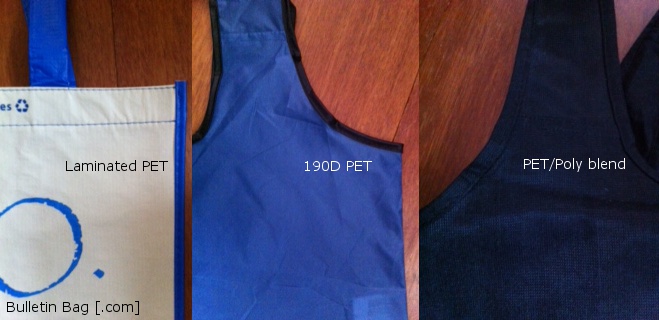So you’re going to commit to using reusable shopping bags. Good for you! Make sure you choose a reusable shopping bag that best suits your individual needs. The more you like your bags, the more you’ll remember to use them!
But how do you choose a reusable shopping bag that’s right for you? It all depends on 1) material preference, 2) price, 3) handles and other features, and 4) how many bags are needed.
1. Material Preference: There are many material options for reusable bags—and new materials are being developed. Reusable bags are most commonly made from nonwoven polypropylene, cotton, laminated materials, polyester or (ripstop) nylon, recycled PET, or natural (jute/bamboo/hemp).
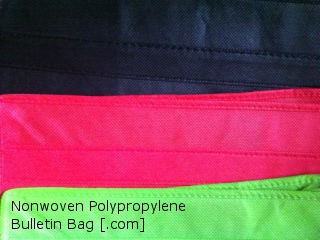 Nonwoven Poly: The majority of the inexpensive bags you see at retail stores today are made of nonwoven polypropylene, which is a form of plastic made to look and feel like cloth. This material option is extremely popular because it is, by far, the most economical—making it easier to kick the single-use bag habit. These bags can be strong and mighty, and lay flat for storage (some nonwoven bags fold into little pouches as well). They can be vibrant and colorful and are often available with four-color process printing. They do require hand washing, either in a sink with soapy water, or by spraying them down with a water/bleach mixture or disinfectant spray cleaner. Nonwoven polypropylene is #5 recyclable at the end of its life, but take care to remove any grommets, snaps etc. before recycling. Some nonwoven polypropylene is made from virgin materials and some is made from a mix of new materials and post consumer/industrial recycled materials (check with your bag supplier to determine if your bags are made from recycled materials). Here is a close up of nonwoven polypropylene material:
Nonwoven Poly: The majority of the inexpensive bags you see at retail stores today are made of nonwoven polypropylene, which is a form of plastic made to look and feel like cloth. This material option is extremely popular because it is, by far, the most economical—making it easier to kick the single-use bag habit. These bags can be strong and mighty, and lay flat for storage (some nonwoven bags fold into little pouches as well). They can be vibrant and colorful and are often available with four-color process printing. They do require hand washing, either in a sink with soapy water, or by spraying them down with a water/bleach mixture or disinfectant spray cleaner. Nonwoven polypropylene is #5 recyclable at the end of its life, but take care to remove any grommets, snaps etc. before recycling. Some nonwoven polypropylene is made from virgin materials and some is made from a mix of new materials and post consumer/industrial recycled materials (check with your bag supplier to determine if your bags are made from recycled materials). Here is a close up of nonwoven polypropylene material:
 Cotton: Do you want to throw your bags in the washing machine to keep them clean? If so, natural-fiber cotton is your best bet—but wash in cold water to preserve the screenprinted logo. Organic cottons are more expensive, but better for the environment, since pesticides are not used when farming it. Recycled cotton is another option and is made from various percentages of post-industrial recycled/reclaimed cotton. Here’s a close up of cotton canvas (please note, cotton weight/look/feel varies by the bag):
Cotton: Do you want to throw your bags in the washing machine to keep them clean? If so, natural-fiber cotton is your best bet—but wash in cold water to preserve the screenprinted logo. Organic cottons are more expensive, but better for the environment, since pesticides are not used when farming it. Recycled cotton is another option and is made from various percentages of post-industrial recycled/reclaimed cotton. Here’s a close up of cotton canvas (please note, cotton weight/look/feel varies by the bag):
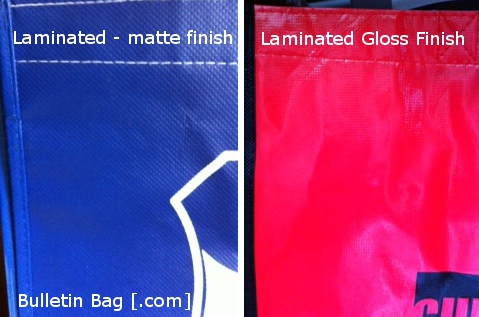 Laminated Shopping Bags: If you like to spray your bags and wipe them down, you’ll probably prefer a laminated reusable bag! Laminated bags are made from laminated woven polypropylene, laminated nonwoven polypropylene, or laminated recycled PET. The difference between the base materials can be seen from the inside of the bag — the outside of the bag has the same basic look. Some laminated bags have a gloss finish and some may have a matte finish, which refers to the sheen on the lamination. Some laminated bags are made from various levels of post consumer or post industrial content so check with the manufacturer to confirm if recycled content was used and/or whether the recycled content is ‘post consumer’ or ‘post industrial’. Here’s a close up of laminated bag material:
Laminated Shopping Bags: If you like to spray your bags and wipe them down, you’ll probably prefer a laminated reusable bag! Laminated bags are made from laminated woven polypropylene, laminated nonwoven polypropylene, or laminated recycled PET. The difference between the base materials can be seen from the inside of the bag — the outside of the bag has the same basic look. Some laminated bags have a gloss finish and some may have a matte finish, which refers to the sheen on the lamination. Some laminated bags are made from various levels of post consumer or post industrial content so check with the manufacturer to confirm if recycled content was used and/or whether the recycled content is ‘post consumer’ or ‘post industrial’. Here’s a close up of laminated bag material:
Poly/Ripstop: Reusable bags made from polyester or nylon are very popular because they are thin, durable, and compact. For lack of a better comparison, the materials look and feel like a windbreaker jacket. Polyester and nylon bags have a higher perceived value than some of the other reusable bag options but the price is still reasonable. Most of these bags include pouches or straps to fold up easily on the go. It’s fine to machine wash a poly/nylon bag if the bag doesn’t have printing, but if it’s been decorated with a logo or artwork you should rinse it in the sink or spray it down to preserve the bag’s printing. Here are examples of poly/nylon materials: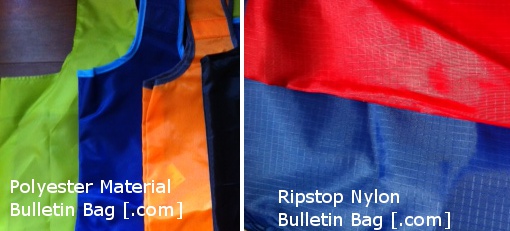
Recycled PET: Often referred to as ‘recycled soda bottles’, recycled PET is another popular material option for reusable bags. The percentage of recycled content varies by supplier and bag. Recycled PET is made from post consumer recycled plastics (#1 recyclables) which includes soda and water bottles. There are several ways this material can be made into fabric. PET material might be used as a base material with a laminated exterior (far left); or it can be combined with polyester and made to look more like the poly/nylon bags (middle) or it can be blended with polyester for a fabric that is soft to the touch (far right):
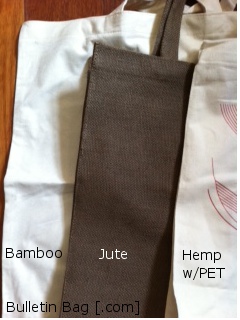 Natural: (Jute, Bamboo or Hemp) Reusable bags made from jute, bamboo or hemp can be hard to find and are often more expensive than other bag options, but they are favorites among die-hard environmentalists. These materials tend to ‘grow like weeds’ which minimizes and sometimes eliminates the use of harsh chemicals and pesticides, while using less water to grow. Jute, bamboo and hemp are often mixed with materials such as cotton or nonwoven polypropylene, so the look and feel (and durability) varies greatly from bag to bag. In their purest state, these materials have a ‘grainy’ feel to them. Here are a few examples:
Natural: (Jute, Bamboo or Hemp) Reusable bags made from jute, bamboo or hemp can be hard to find and are often more expensive than other bag options, but they are favorites among die-hard environmentalists. These materials tend to ‘grow like weeds’ which minimizes and sometimes eliminates the use of harsh chemicals and pesticides, while using less water to grow. Jute, bamboo and hemp are often mixed with materials such as cotton or nonwoven polypropylene, so the look and feel (and durability) varies greatly from bag to bag. In their purest state, these materials have a ‘grainy’ feel to them. Here are a few examples:
2. Price: It’s important to think about your budget before you start looking at bags. If you see samples of $8 bags before discovering that you can only afford $2 bags, you’re going to be disappointed. Like all other products, you get what you pay for, and a more expensive bag is generally going to be better quality. Here are some guidelines on pricing for grocery style bags:
Least Expensive ($1-$2 per bag): Primarily nonwoven polypropylene bags, and a few exceptions for small, nylon bags.
Mid Price Range ($2-$4 per bag): You’ll find the most selection in this price range. Laminated bags tend to be in the $2-3 range. Poly/nylon bags tend to be in the $2.50-$3.50 range. Cotton has seen sharp increases in 2011 and most cotton bags are now in the $3-$4 range with limited options under $3.
Most Expensive ($4+ per bag): Primarily organic cotton, recycled cotton, hemp and jute. Also, bags with fancy handles and lots of details (pockets, grommets, etc.)
3. Handles and Other Features: Some bags fold, some zip, some snap, some are small and some are large. Here are a few more considerations when choosing your reusable bags:
Handle Length: Do you like holding full bags on your shoulder? If so, look for 20” or more in handle length (measured from seam to seam in a loop. Prefer to hand-carry? Look for handles around 18” or shorter in length.
Gusset Size: The gusset refers to the bag’s depth. If the bag is meant for groceries, look for a generous gusset. Some bags are flat with no gusset, others have a bottom gusset only and others have full 3-sided gussets (panels on both sides and the bottom).
Fold Up Bags: Many reusable bags on the market today are designed to fold into themselves or a pouch for easy portability. These bags are super handy and perfect for unexpected trips to the store since they are small enough to be stored in a purse, pocket, car cup holder, briefcase or backpack. Some folding bags will have snaps, zippers, drawstrings, or Velcro to hold them together. Beware of inexpensive bags with zippers, as oftentimes the zippers break easily.
Bag Color: Many bags come in an array of colors, but some do not. Make sure the bag you fall in love with comes in a color you can live with.
Imprinting: If you’re planning to print a logo or design on the bag, keep in mind that you will pay more for multiple colors in your design. If your design is in ‘full color process’ you will most likely need a bag that can be printed with a high quality heat transfer. You’ll want to talk to your bag supplier to make sure they have seen your logo and understand the best print method for your design and budget. If you’re looking for full color graphics and ‘all over’ printing, expect to wait 90 days for production with minimums of 2500+.
Insulation: Some grocery bags are lined with thermal insulation, which keeps cold foods cold while in transit. These are typically more expensive than regular grocery bags, but it’s a great idea to have at least one of these bags in your mix.
Wine Bottle Bags and Bottle Sleeves: Some bags are designed specifically for 1, 2, 4 or 6 bottles of wine. Other bags have interior bottle ‘sleeves’ that hold drinks upright while in transit. These can be very handy!
4. How Many Bags Are Needed? The rule of thumb is that for weekly shopping you should have about 2-3 bags per member of your household. Using that as a guide, a family of four needs 8-12 bags per trip to the store). It’s always a good idea to have a few extras kicking around in the home, car, or office for unexpected shopping trips (grocery, mall, or other).
Reusable bags are so prevalent in our society, and there are tons of choices. Some buy a few high-end bags that might be meant for fashion and style over functionality. Many people use whatever custom reusable bags they get as freebies at events. Even with those, people find favorites amongst them. What’s your favorite? Why? Let us know!

